Critical Appreciation of the Article on Effect of Inhaled Lavender and Sleep Hygiene on Self-Reported Sleep Issues
VerifiedAdded on 2023/02/01
|11
|2486
|63
AI Summary
This paper provides a critical appreciation of the article on the effect of inhaled lavender and sleep hygiene on self-reported sleep issues. It discusses the literature review, aims or hypotheses, evaluation of the methods section, evaluation of the results section, and conclusion.
Contribute Materials
Your contribution can guide someone’s learning journey. Share your
documents today.
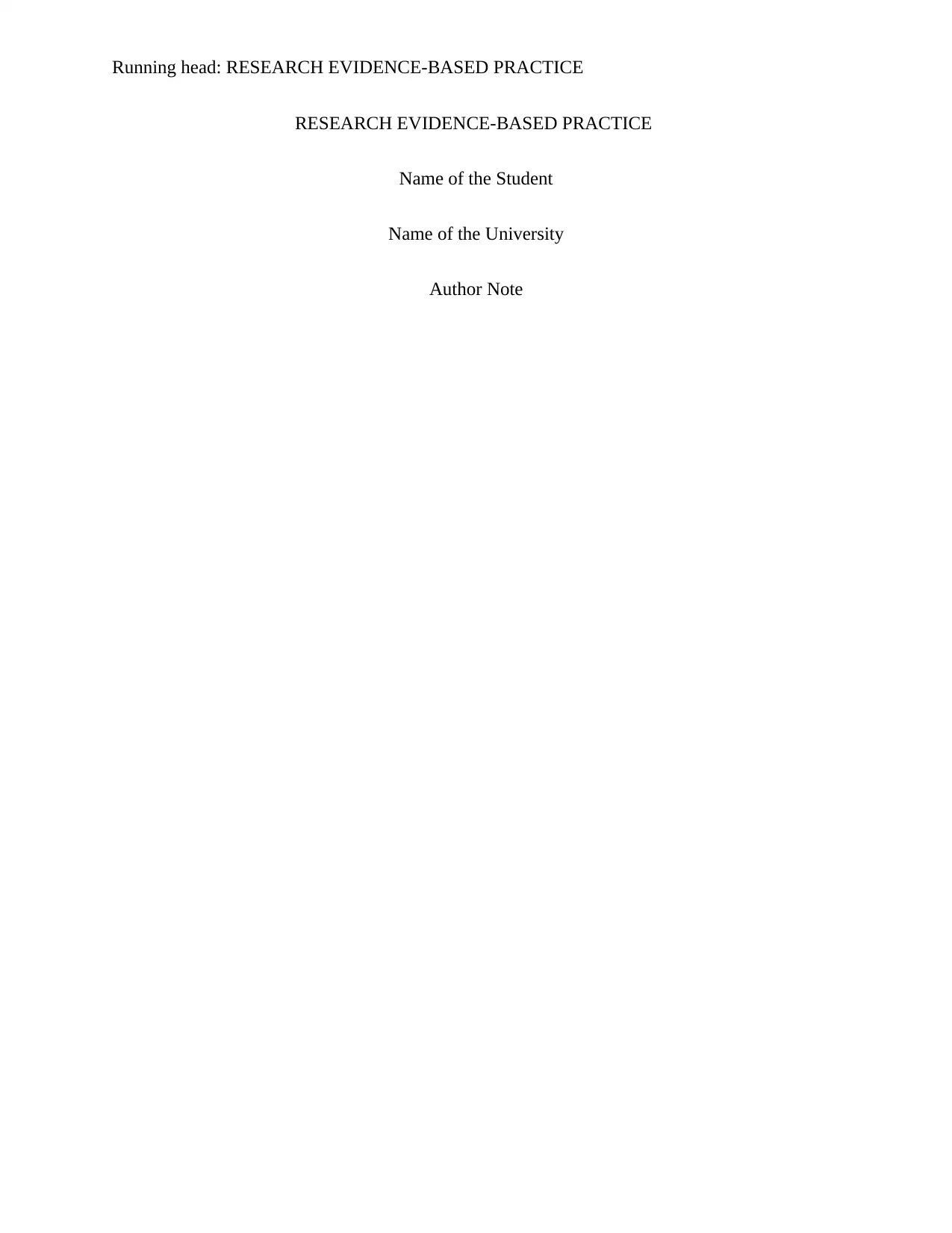
Running head: RESEARCH EVIDENCE-BASED PRACTICE
RESEARCH EVIDENCE-BASED PRACTICE
Name of the Student
Name of the University
Author Note
RESEARCH EVIDENCE-BASED PRACTICE
Name of the Student
Name of the University
Author Note
Secure Best Marks with AI Grader
Need help grading? Try our AI Grader for instant feedback on your assignments.
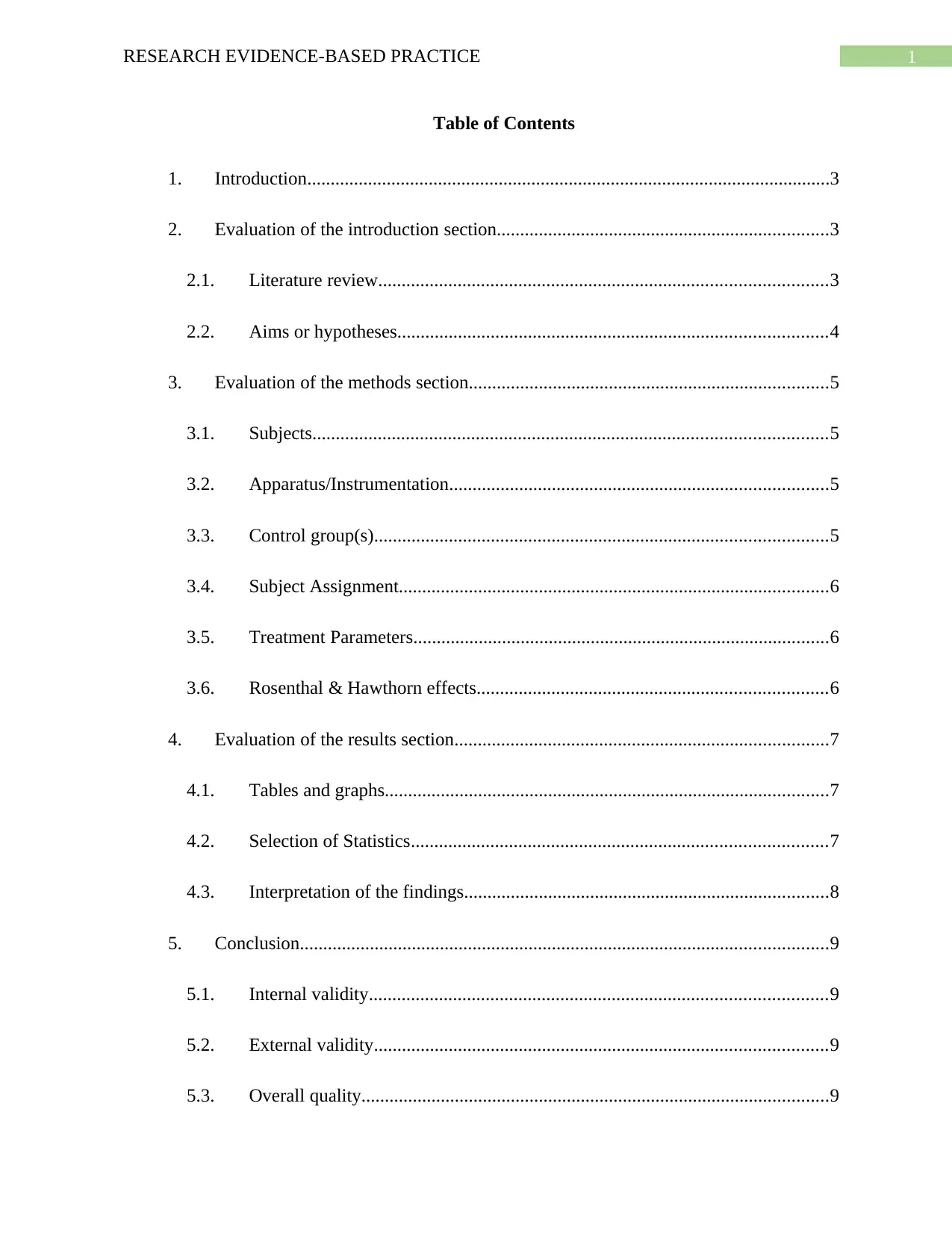
1RESEARCH EVIDENCE-BASED PRACTICE
Table of Contents
1. Introduction................................................................................................................3
2. Evaluation of the introduction section.......................................................................3
2.1. Literature review................................................................................................3
2.2. Aims or hypotheses............................................................................................4
3. Evaluation of the methods section.............................................................................5
3.1. Subjects..............................................................................................................5
3.2. Apparatus/Instrumentation.................................................................................5
3.3. Control group(s).................................................................................................5
3.4. Subject Assignment............................................................................................6
3.5. Treatment Parameters.........................................................................................6
3.6. Rosenthal & Hawthorn effects...........................................................................6
4. Evaluation of the results section................................................................................7
4.1. Tables and graphs...............................................................................................7
4.2. Selection of Statistics.........................................................................................7
4.3. Interpretation of the findings..............................................................................8
5. Conclusion.................................................................................................................9
5.1. Internal validity..................................................................................................9
5.2. External validity.................................................................................................9
5.3. Overall quality....................................................................................................9
Table of Contents
1. Introduction................................................................................................................3
2. Evaluation of the introduction section.......................................................................3
2.1. Literature review................................................................................................3
2.2. Aims or hypotheses............................................................................................4
3. Evaluation of the methods section.............................................................................5
3.1. Subjects..............................................................................................................5
3.2. Apparatus/Instrumentation.................................................................................5
3.3. Control group(s).................................................................................................5
3.4. Subject Assignment............................................................................................6
3.5. Treatment Parameters.........................................................................................6
3.6. Rosenthal & Hawthorn effects...........................................................................6
4. Evaluation of the results section................................................................................7
4.1. Tables and graphs...............................................................................................7
4.2. Selection of Statistics.........................................................................................7
4.3. Interpretation of the findings..............................................................................8
5. Conclusion.................................................................................................................9
5.1. Internal validity..................................................................................................9
5.2. External validity.................................................................................................9
5.3. Overall quality....................................................................................................9
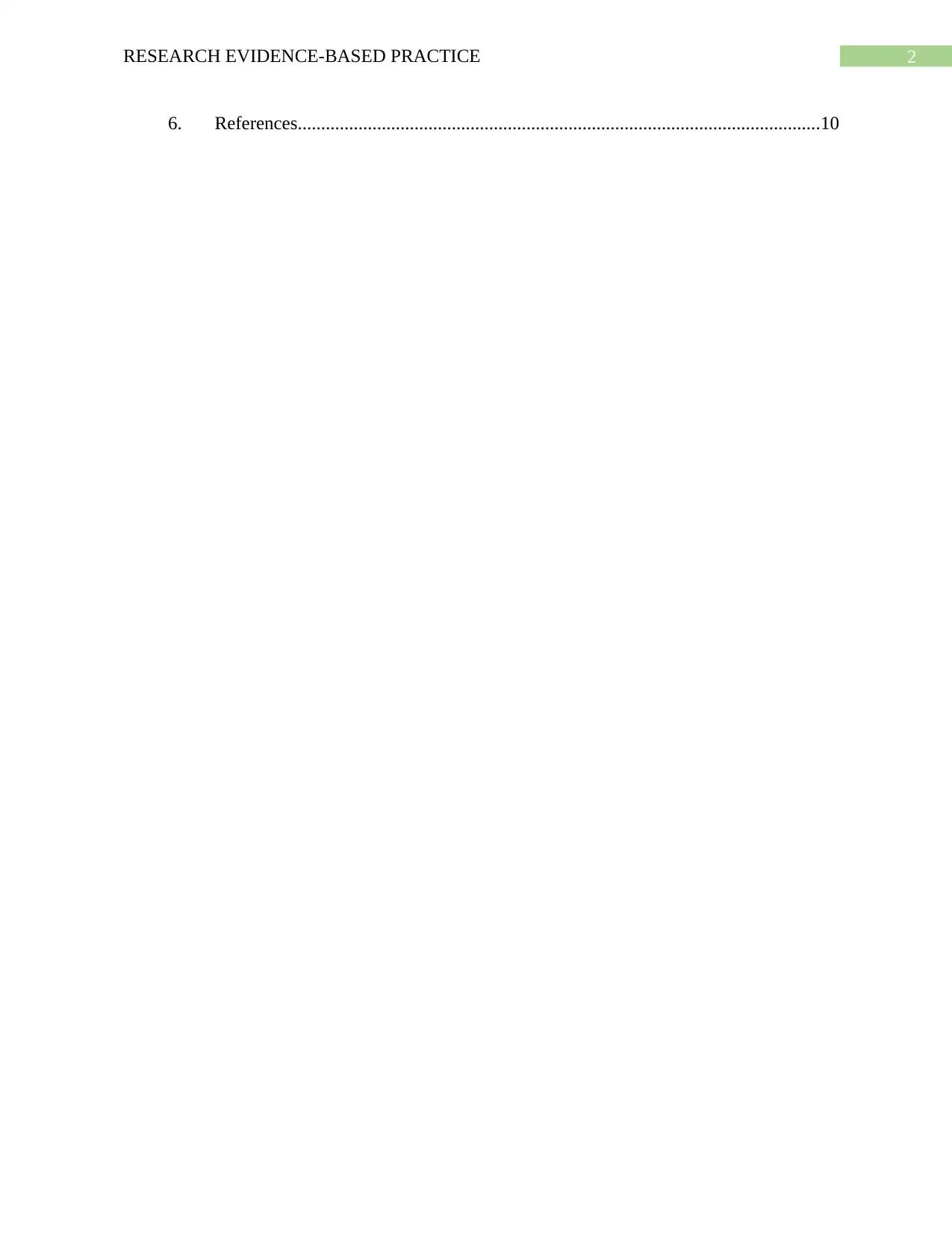
2RESEARCH EVIDENCE-BASED PRACTICE
6. References................................................................................................................10
6. References................................................................................................................10
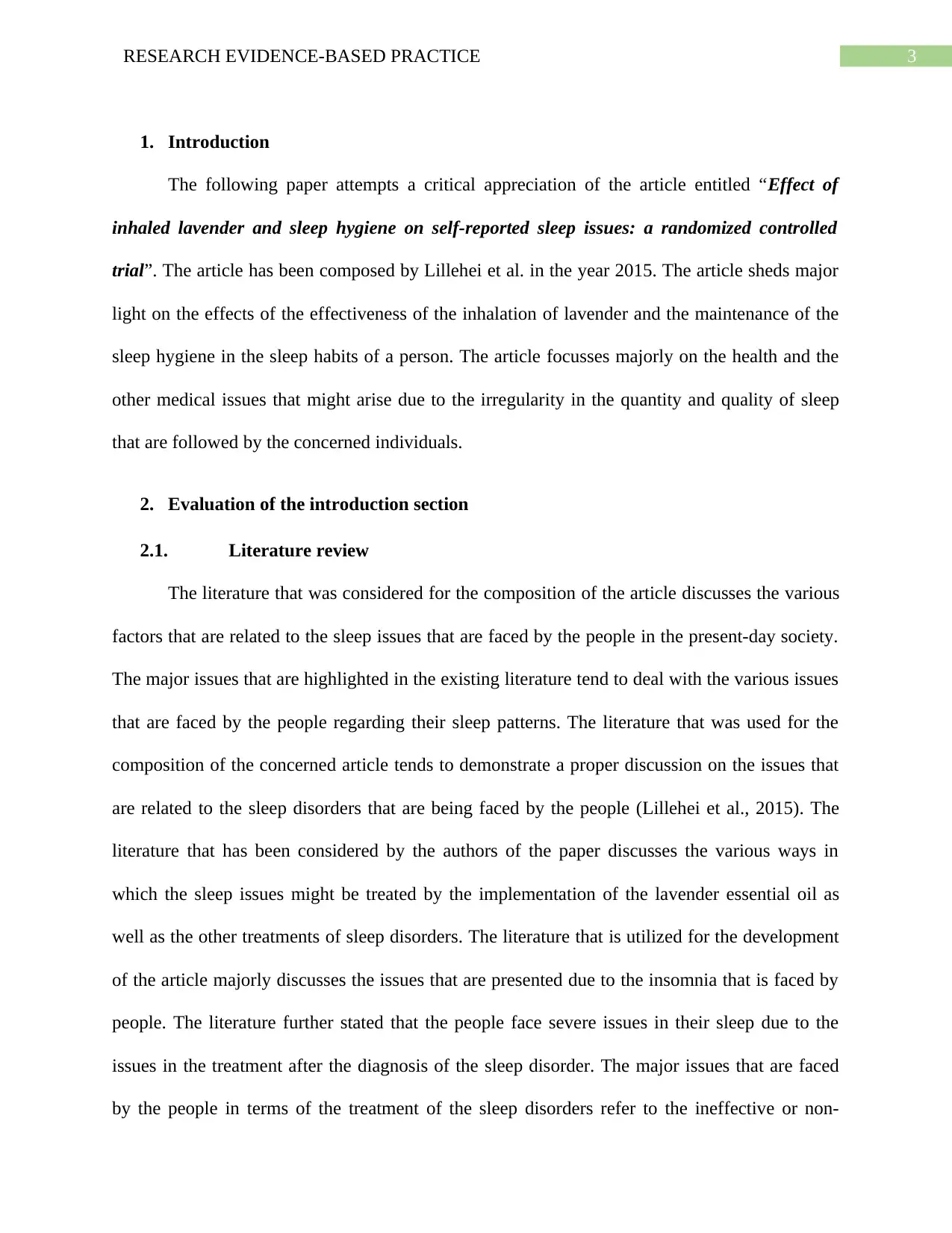
3RESEARCH EVIDENCE-BASED PRACTICE
1. Introduction
The following paper attempts a critical appreciation of the article entitled “Effect of
inhaled lavender and sleep hygiene on self-reported sleep issues: a randomized controlled
trial”. The article has been composed by Lillehei et al. in the year 2015. The article sheds major
light on the effects of the effectiveness of the inhalation of lavender and the maintenance of the
sleep hygiene in the sleep habits of a person. The article focusses majorly on the health and the
other medical issues that might arise due to the irregularity in the quantity and quality of sleep
that are followed by the concerned individuals.
2. Evaluation of the introduction section
2.1. Literature review
The literature that was considered for the composition of the article discusses the various
factors that are related to the sleep issues that are faced by the people in the present-day society.
The major issues that are highlighted in the existing literature tend to deal with the various issues
that are faced by the people regarding their sleep patterns. The literature that was used for the
composition of the concerned article tends to demonstrate a proper discussion on the issues that
are related to the sleep disorders that are being faced by the people (Lillehei et al., 2015). The
literature that has been considered by the authors of the paper discusses the various ways in
which the sleep issues might be treated by the implementation of the lavender essential oil as
well as the other treatments of sleep disorders. The literature that is utilized for the development
of the article majorly discusses the issues that are presented due to the insomnia that is faced by
people. The literature further stated that the people face severe issues in their sleep due to the
issues in the treatment after the diagnosis of the sleep disorder. The major issues that are faced
by the people in terms of the treatment of the sleep disorders refer to the ineffective or non-
1. Introduction
The following paper attempts a critical appreciation of the article entitled “Effect of
inhaled lavender and sleep hygiene on self-reported sleep issues: a randomized controlled
trial”. The article has been composed by Lillehei et al. in the year 2015. The article sheds major
light on the effects of the effectiveness of the inhalation of lavender and the maintenance of the
sleep hygiene in the sleep habits of a person. The article focusses majorly on the health and the
other medical issues that might arise due to the irregularity in the quantity and quality of sleep
that are followed by the concerned individuals.
2. Evaluation of the introduction section
2.1. Literature review
The literature that was considered for the composition of the article discusses the various
factors that are related to the sleep issues that are faced by the people in the present-day society.
The major issues that are highlighted in the existing literature tend to deal with the various issues
that are faced by the people regarding their sleep patterns. The literature that was used for the
composition of the concerned article tends to demonstrate a proper discussion on the issues that
are related to the sleep disorders that are being faced by the people (Lillehei et al., 2015). The
literature that has been considered by the authors of the paper discusses the various ways in
which the sleep issues might be treated by the implementation of the lavender essential oil as
well as the other treatments of sleep disorders. The literature that is utilized for the development
of the article majorly discusses the issues that are presented due to the insomnia that is faced by
people. The literature further stated that the people face severe issues in their sleep due to the
issues in the treatment after the diagnosis of the sleep disorder. The major issues that are faced
by the people in terms of the treatment of the sleep disorders refer to the ineffective or non-
Secure Best Marks with AI Grader
Need help grading? Try our AI Grader for instant feedback on your assignments.
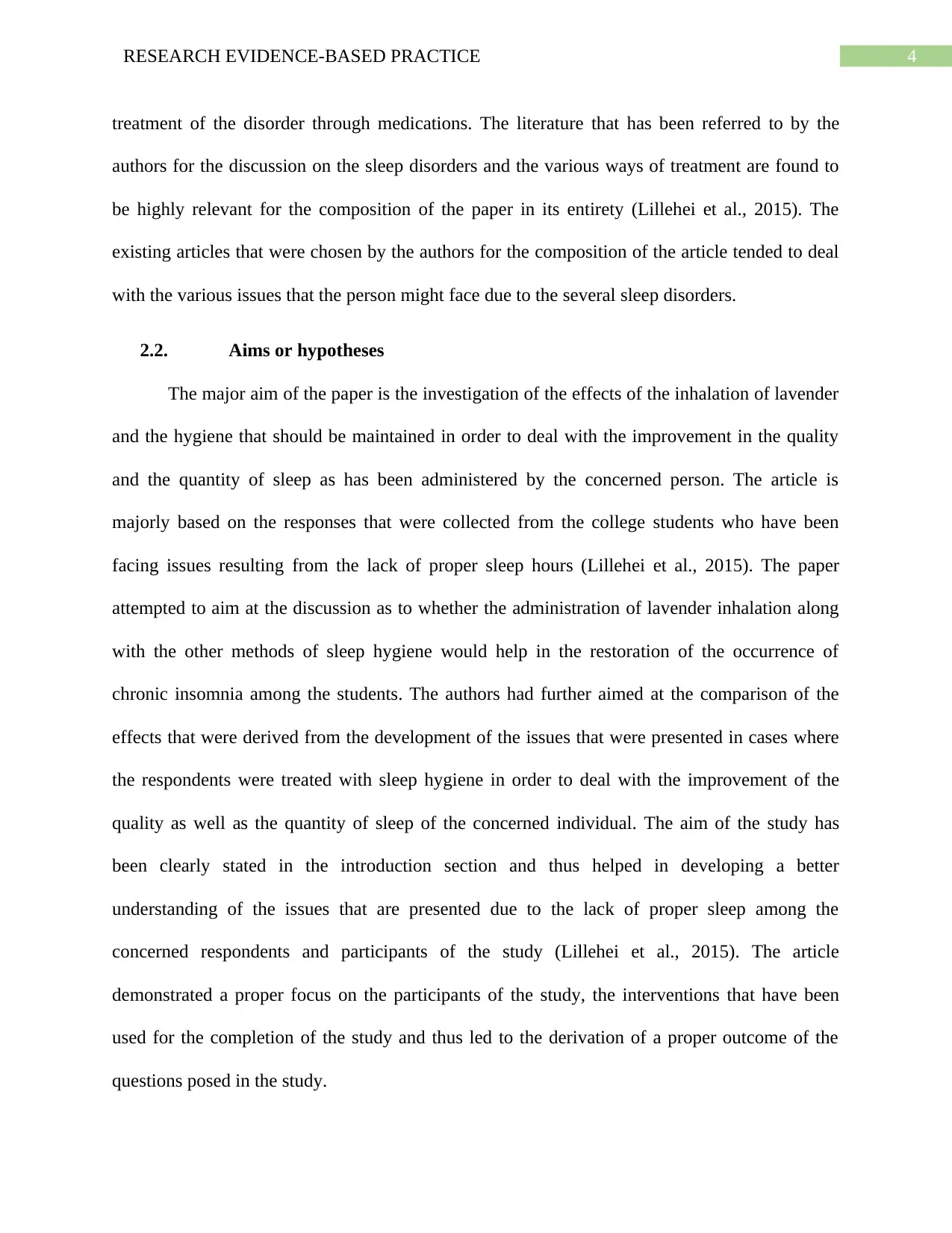
4RESEARCH EVIDENCE-BASED PRACTICE
treatment of the disorder through medications. The literature that has been referred to by the
authors for the discussion on the sleep disorders and the various ways of treatment are found to
be highly relevant for the composition of the paper in its entirety (Lillehei et al., 2015). The
existing articles that were chosen by the authors for the composition of the article tended to deal
with the various issues that the person might face due to the several sleep disorders.
2.2. Aims or hypotheses
The major aim of the paper is the investigation of the effects of the inhalation of lavender
and the hygiene that should be maintained in order to deal with the improvement in the quality
and the quantity of sleep as has been administered by the concerned person. The article is
majorly based on the responses that were collected from the college students who have been
facing issues resulting from the lack of proper sleep hours (Lillehei et al., 2015). The paper
attempted to aim at the discussion as to whether the administration of lavender inhalation along
with the other methods of sleep hygiene would help in the restoration of the occurrence of
chronic insomnia among the students. The authors had further aimed at the comparison of the
effects that were derived from the development of the issues that were presented in cases where
the respondents were treated with sleep hygiene in order to deal with the improvement of the
quality as well as the quantity of sleep of the concerned individual. The aim of the study has
been clearly stated in the introduction section and thus helped in developing a better
understanding of the issues that are presented due to the lack of proper sleep among the
concerned respondents and participants of the study (Lillehei et al., 2015). The article
demonstrated a proper focus on the participants of the study, the interventions that have been
used for the completion of the study and thus led to the derivation of a proper outcome of the
questions posed in the study.
treatment of the disorder through medications. The literature that has been referred to by the
authors for the discussion on the sleep disorders and the various ways of treatment are found to
be highly relevant for the composition of the paper in its entirety (Lillehei et al., 2015). The
existing articles that were chosen by the authors for the composition of the article tended to deal
with the various issues that the person might face due to the several sleep disorders.
2.2. Aims or hypotheses
The major aim of the paper is the investigation of the effects of the inhalation of lavender
and the hygiene that should be maintained in order to deal with the improvement in the quality
and the quantity of sleep as has been administered by the concerned person. The article is
majorly based on the responses that were collected from the college students who have been
facing issues resulting from the lack of proper sleep hours (Lillehei et al., 2015). The paper
attempted to aim at the discussion as to whether the administration of lavender inhalation along
with the other methods of sleep hygiene would help in the restoration of the occurrence of
chronic insomnia among the students. The authors had further aimed at the comparison of the
effects that were derived from the development of the issues that were presented in cases where
the respondents were treated with sleep hygiene in order to deal with the improvement of the
quality as well as the quantity of sleep of the concerned individual. The aim of the study has
been clearly stated in the introduction section and thus helped in developing a better
understanding of the issues that are presented due to the lack of proper sleep among the
concerned respondents and participants of the study (Lillehei et al., 2015). The article
demonstrated a proper focus on the participants of the study, the interventions that have been
used for the completion of the study and thus led to the derivation of a proper outcome of the
questions posed in the study.
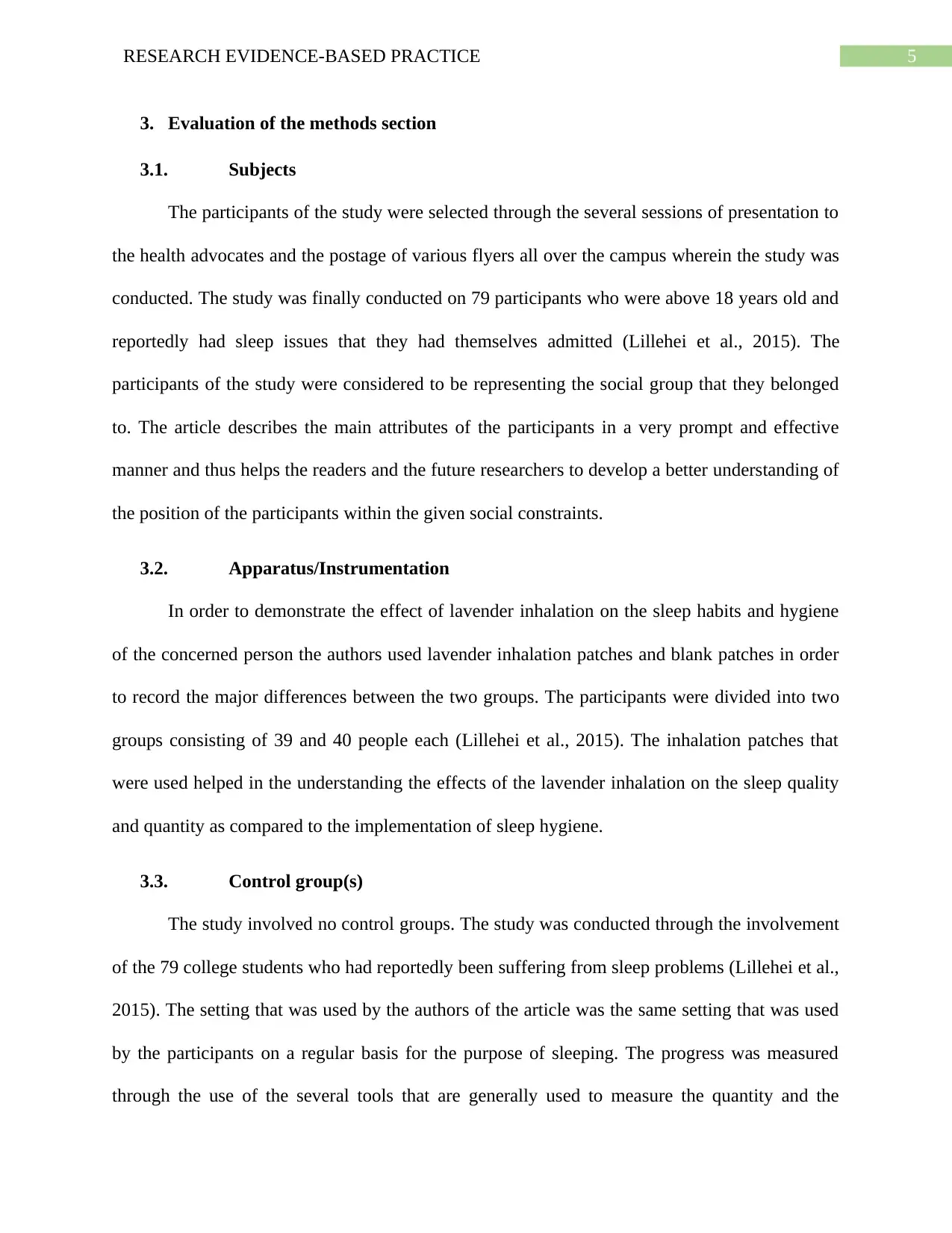
5RESEARCH EVIDENCE-BASED PRACTICE
3. Evaluation of the methods section
3.1. Subjects
The participants of the study were selected through the several sessions of presentation to
the health advocates and the postage of various flyers all over the campus wherein the study was
conducted. The study was finally conducted on 79 participants who were above 18 years old and
reportedly had sleep issues that they had themselves admitted (Lillehei et al., 2015). The
participants of the study were considered to be representing the social group that they belonged
to. The article describes the main attributes of the participants in a very prompt and effective
manner and thus helps the readers and the future researchers to develop a better understanding of
the position of the participants within the given social constraints.
3.2. Apparatus/Instrumentation
In order to demonstrate the effect of lavender inhalation on the sleep habits and hygiene
of the concerned person the authors used lavender inhalation patches and blank patches in order
to record the major differences between the two groups. The participants were divided into two
groups consisting of 39 and 40 people each (Lillehei et al., 2015). The inhalation patches that
were used helped in the understanding the effects of the lavender inhalation on the sleep quality
and quantity as compared to the implementation of sleep hygiene.
3.3. Control group(s)
The study involved no control groups. The study was conducted through the involvement
of the 79 college students who had reportedly been suffering from sleep problems (Lillehei et al.,
2015). The setting that was used by the authors of the article was the same setting that was used
by the participants on a regular basis for the purpose of sleeping. The progress was measured
through the use of the several tools that are generally used to measure the quantity and the
3. Evaluation of the methods section
3.1. Subjects
The participants of the study were selected through the several sessions of presentation to
the health advocates and the postage of various flyers all over the campus wherein the study was
conducted. The study was finally conducted on 79 participants who were above 18 years old and
reportedly had sleep issues that they had themselves admitted (Lillehei et al., 2015). The
participants of the study were considered to be representing the social group that they belonged
to. The article describes the main attributes of the participants in a very prompt and effective
manner and thus helps the readers and the future researchers to develop a better understanding of
the position of the participants within the given social constraints.
3.2. Apparatus/Instrumentation
In order to demonstrate the effect of lavender inhalation on the sleep habits and hygiene
of the concerned person the authors used lavender inhalation patches and blank patches in order
to record the major differences between the two groups. The participants were divided into two
groups consisting of 39 and 40 people each (Lillehei et al., 2015). The inhalation patches that
were used helped in the understanding the effects of the lavender inhalation on the sleep quality
and quantity as compared to the implementation of sleep hygiene.
3.3. Control group(s)
The study involved no control groups. The study was conducted through the involvement
of the 79 college students who had reportedly been suffering from sleep problems (Lillehei et al.,
2015). The setting that was used by the authors of the article was the same setting that was used
by the participants on a regular basis for the purpose of sleeping. The progress was measured
through the use of the several tools that are generally used to measure the quantity and the
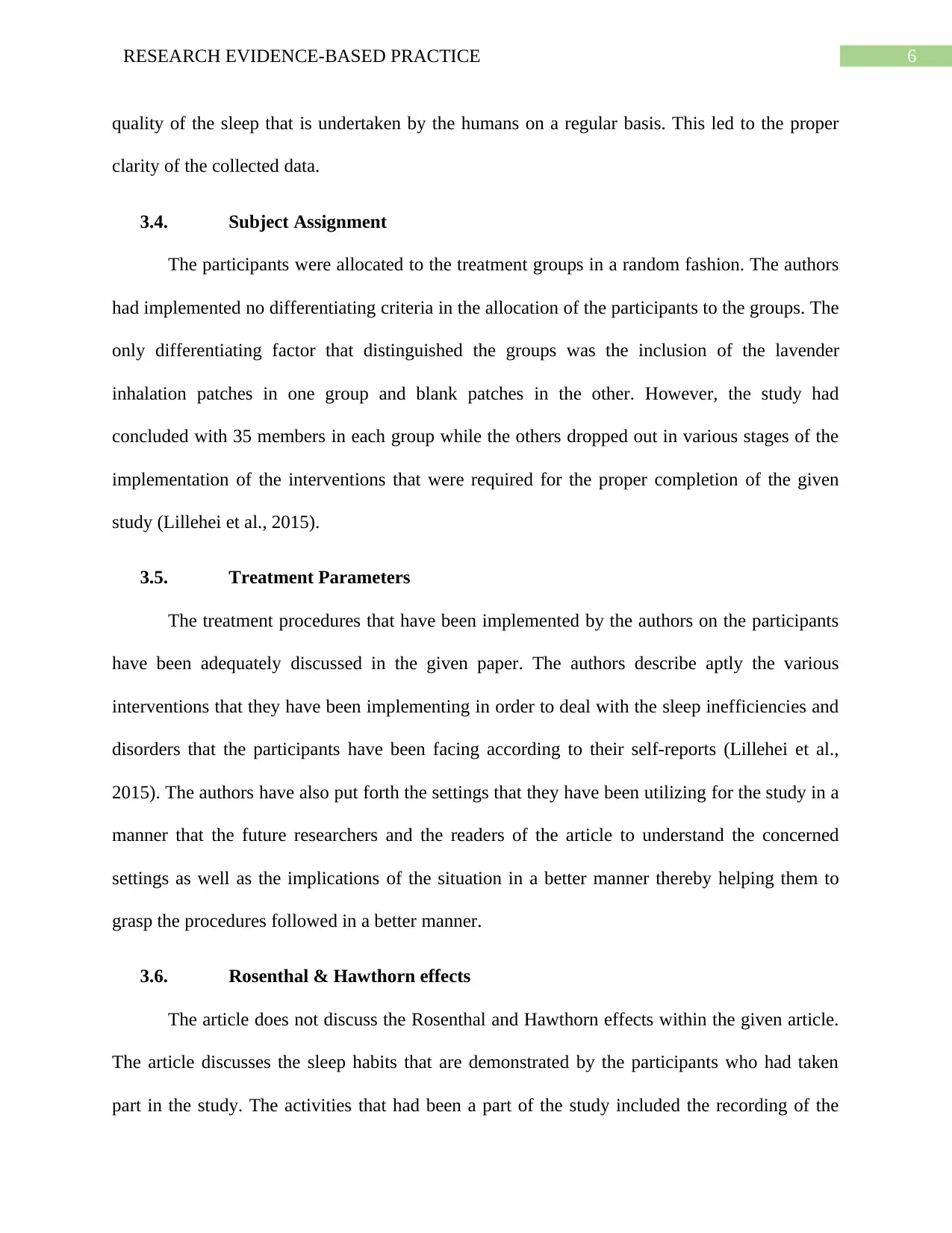
6RESEARCH EVIDENCE-BASED PRACTICE
quality of the sleep that is undertaken by the humans on a regular basis. This led to the proper
clarity of the collected data.
3.4. Subject Assignment
The participants were allocated to the treatment groups in a random fashion. The authors
had implemented no differentiating criteria in the allocation of the participants to the groups. The
only differentiating factor that distinguished the groups was the inclusion of the lavender
inhalation patches in one group and blank patches in the other. However, the study had
concluded with 35 members in each group while the others dropped out in various stages of the
implementation of the interventions that were required for the proper completion of the given
study (Lillehei et al., 2015).
3.5. Treatment Parameters
The treatment procedures that have been implemented by the authors on the participants
have been adequately discussed in the given paper. The authors describe aptly the various
interventions that they have been implementing in order to deal with the sleep inefficiencies and
disorders that the participants have been facing according to their self-reports (Lillehei et al.,
2015). The authors have also put forth the settings that they have been utilizing for the study in a
manner that the future researchers and the readers of the article to understand the concerned
settings as well as the implications of the situation in a better manner thereby helping them to
grasp the procedures followed in a better manner.
3.6. Rosenthal & Hawthorn effects
The article does not discuss the Rosenthal and Hawthorn effects within the given article.
The article discusses the sleep habits that are demonstrated by the participants who had taken
part in the study. The activities that had been a part of the study included the recording of the
quality of the sleep that is undertaken by the humans on a regular basis. This led to the proper
clarity of the collected data.
3.4. Subject Assignment
The participants were allocated to the treatment groups in a random fashion. The authors
had implemented no differentiating criteria in the allocation of the participants to the groups. The
only differentiating factor that distinguished the groups was the inclusion of the lavender
inhalation patches in one group and blank patches in the other. However, the study had
concluded with 35 members in each group while the others dropped out in various stages of the
implementation of the interventions that were required for the proper completion of the given
study (Lillehei et al., 2015).
3.5. Treatment Parameters
The treatment procedures that have been implemented by the authors on the participants
have been adequately discussed in the given paper. The authors describe aptly the various
interventions that they have been implementing in order to deal with the sleep inefficiencies and
disorders that the participants have been facing according to their self-reports (Lillehei et al.,
2015). The authors have also put forth the settings that they have been utilizing for the study in a
manner that the future researchers and the readers of the article to understand the concerned
settings as well as the implications of the situation in a better manner thereby helping them to
grasp the procedures followed in a better manner.
3.6. Rosenthal & Hawthorn effects
The article does not discuss the Rosenthal and Hawthorn effects within the given article.
The article discusses the sleep habits that are demonstrated by the participants who had taken
part in the study. The activities that had been a part of the study included the recording of the
Paraphrase This Document
Need a fresh take? Get an instant paraphrase of this document with our AI Paraphraser
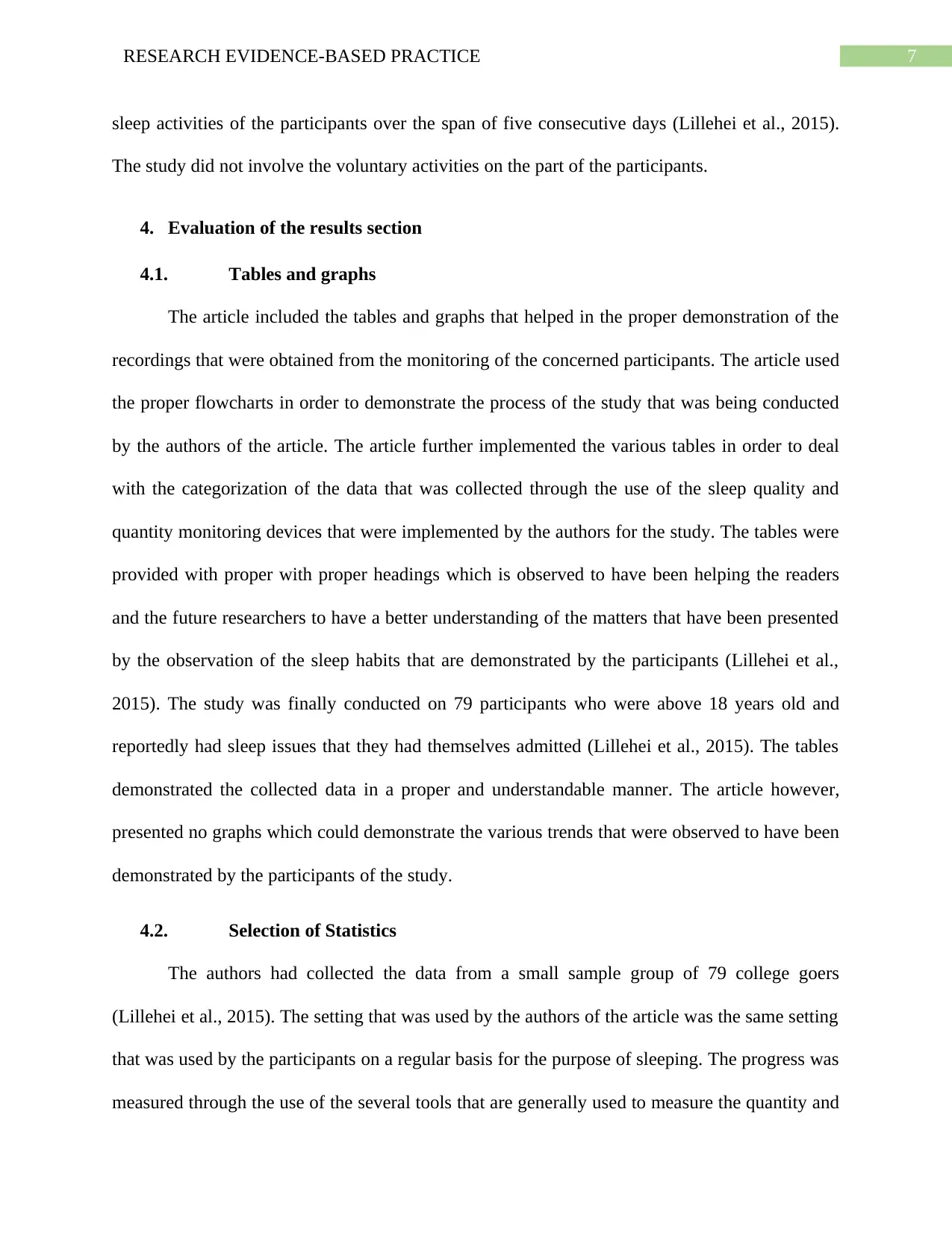
7RESEARCH EVIDENCE-BASED PRACTICE
sleep activities of the participants over the span of five consecutive days (Lillehei et al., 2015).
The study did not involve the voluntary activities on the part of the participants.
4. Evaluation of the results section
4.1. Tables and graphs
The article included the tables and graphs that helped in the proper demonstration of the
recordings that were obtained from the monitoring of the concerned participants. The article used
the proper flowcharts in order to demonstrate the process of the study that was being conducted
by the authors of the article. The article further implemented the various tables in order to deal
with the categorization of the data that was collected through the use of the sleep quality and
quantity monitoring devices that were implemented by the authors for the study. The tables were
provided with proper with proper headings which is observed to have been helping the readers
and the future researchers to have a better understanding of the matters that have been presented
by the observation of the sleep habits that are demonstrated by the participants (Lillehei et al.,
2015). The study was finally conducted on 79 participants who were above 18 years old and
reportedly had sleep issues that they had themselves admitted (Lillehei et al., 2015). The tables
demonstrated the collected data in a proper and understandable manner. The article however,
presented no graphs which could demonstrate the various trends that were observed to have been
demonstrated by the participants of the study.
4.2. Selection of Statistics
The authors had collected the data from a small sample group of 79 college goers
(Lillehei et al., 2015). The setting that was used by the authors of the article was the same setting
that was used by the participants on a regular basis for the purpose of sleeping. The progress was
measured through the use of the several tools that are generally used to measure the quantity and
sleep activities of the participants over the span of five consecutive days (Lillehei et al., 2015).
The study did not involve the voluntary activities on the part of the participants.
4. Evaluation of the results section
4.1. Tables and graphs
The article included the tables and graphs that helped in the proper demonstration of the
recordings that were obtained from the monitoring of the concerned participants. The article used
the proper flowcharts in order to demonstrate the process of the study that was being conducted
by the authors of the article. The article further implemented the various tables in order to deal
with the categorization of the data that was collected through the use of the sleep quality and
quantity monitoring devices that were implemented by the authors for the study. The tables were
provided with proper with proper headings which is observed to have been helping the readers
and the future researchers to have a better understanding of the matters that have been presented
by the observation of the sleep habits that are demonstrated by the participants (Lillehei et al.,
2015). The study was finally conducted on 79 participants who were above 18 years old and
reportedly had sleep issues that they had themselves admitted (Lillehei et al., 2015). The tables
demonstrated the collected data in a proper and understandable manner. The article however,
presented no graphs which could demonstrate the various trends that were observed to have been
demonstrated by the participants of the study.
4.2. Selection of Statistics
The authors had collected the data from a small sample group of 79 college goers
(Lillehei et al., 2015). The setting that was used by the authors of the article was the same setting
that was used by the participants on a regular basis for the purpose of sleeping. The progress was
measured through the use of the several tools that are generally used to measure the quantity and
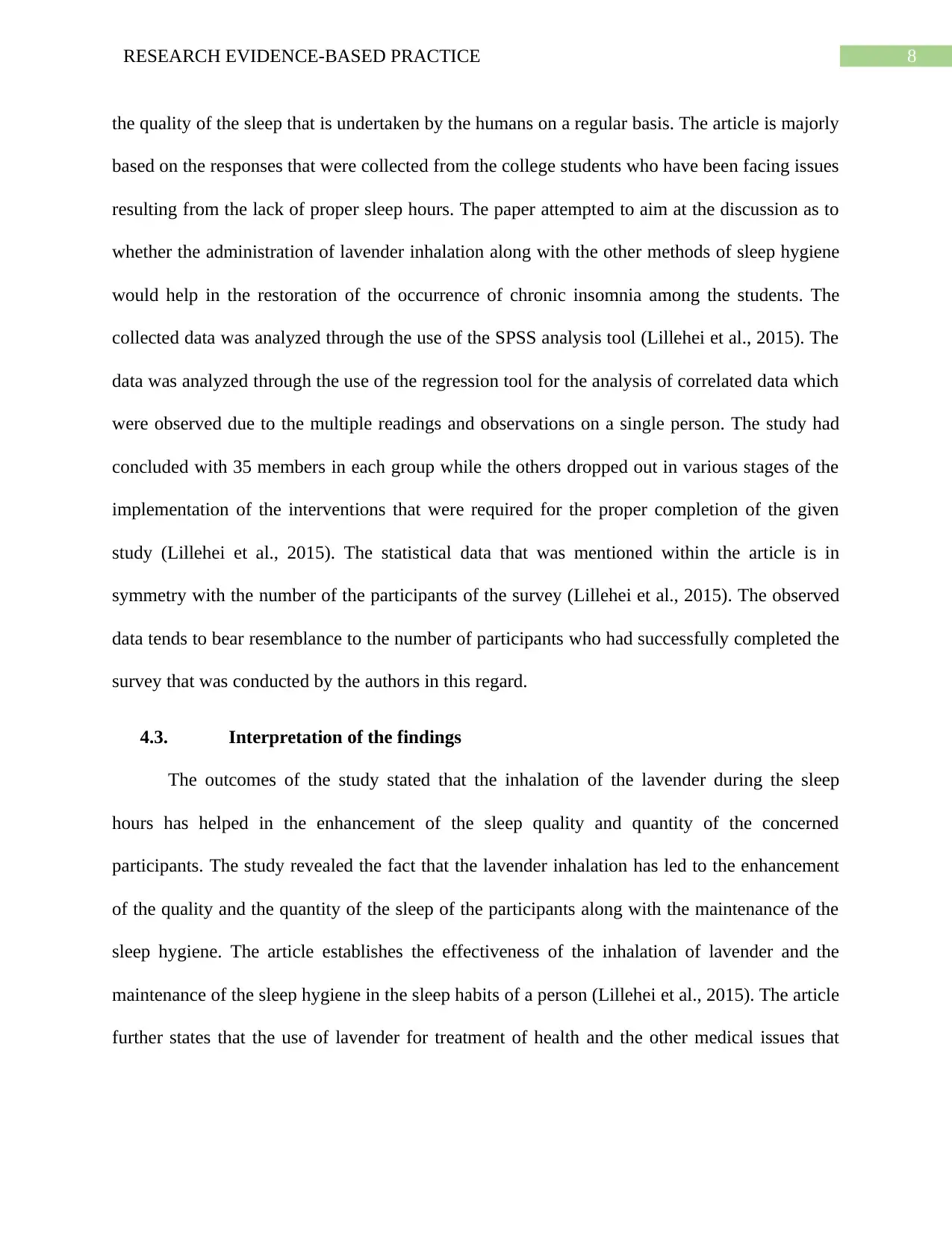
8RESEARCH EVIDENCE-BASED PRACTICE
the quality of the sleep that is undertaken by the humans on a regular basis. The article is majorly
based on the responses that were collected from the college students who have been facing issues
resulting from the lack of proper sleep hours. The paper attempted to aim at the discussion as to
whether the administration of lavender inhalation along with the other methods of sleep hygiene
would help in the restoration of the occurrence of chronic insomnia among the students. The
collected data was analyzed through the use of the SPSS analysis tool (Lillehei et al., 2015). The
data was analyzed through the use of the regression tool for the analysis of correlated data which
were observed due to the multiple readings and observations on a single person. The study had
concluded with 35 members in each group while the others dropped out in various stages of the
implementation of the interventions that were required for the proper completion of the given
study (Lillehei et al., 2015). The statistical data that was mentioned within the article is in
symmetry with the number of the participants of the survey (Lillehei et al., 2015). The observed
data tends to bear resemblance to the number of participants who had successfully completed the
survey that was conducted by the authors in this regard.
4.3. Interpretation of the findings
The outcomes of the study stated that the inhalation of the lavender during the sleep
hours has helped in the enhancement of the sleep quality and quantity of the concerned
participants. The study revealed the fact that the lavender inhalation has led to the enhancement
of the quality and the quantity of the sleep of the participants along with the maintenance of the
sleep hygiene. The article establishes the effectiveness of the inhalation of lavender and the
maintenance of the sleep hygiene in the sleep habits of a person (Lillehei et al., 2015). The article
further states that the use of lavender for treatment of health and the other medical issues that
the quality of the sleep that is undertaken by the humans on a regular basis. The article is majorly
based on the responses that were collected from the college students who have been facing issues
resulting from the lack of proper sleep hours. The paper attempted to aim at the discussion as to
whether the administration of lavender inhalation along with the other methods of sleep hygiene
would help in the restoration of the occurrence of chronic insomnia among the students. The
collected data was analyzed through the use of the SPSS analysis tool (Lillehei et al., 2015). The
data was analyzed through the use of the regression tool for the analysis of correlated data which
were observed due to the multiple readings and observations on a single person. The study had
concluded with 35 members in each group while the others dropped out in various stages of the
implementation of the interventions that were required for the proper completion of the given
study (Lillehei et al., 2015). The statistical data that was mentioned within the article is in
symmetry with the number of the participants of the survey (Lillehei et al., 2015). The observed
data tends to bear resemblance to the number of participants who had successfully completed the
survey that was conducted by the authors in this regard.
4.3. Interpretation of the findings
The outcomes of the study stated that the inhalation of the lavender during the sleep
hours has helped in the enhancement of the sleep quality and quantity of the concerned
participants. The study revealed the fact that the lavender inhalation has led to the enhancement
of the quality and the quantity of the sleep of the participants along with the maintenance of the
sleep hygiene. The article establishes the effectiveness of the inhalation of lavender and the
maintenance of the sleep hygiene in the sleep habits of a person (Lillehei et al., 2015). The article
further states that the use of lavender for treatment of health and the other medical issues that
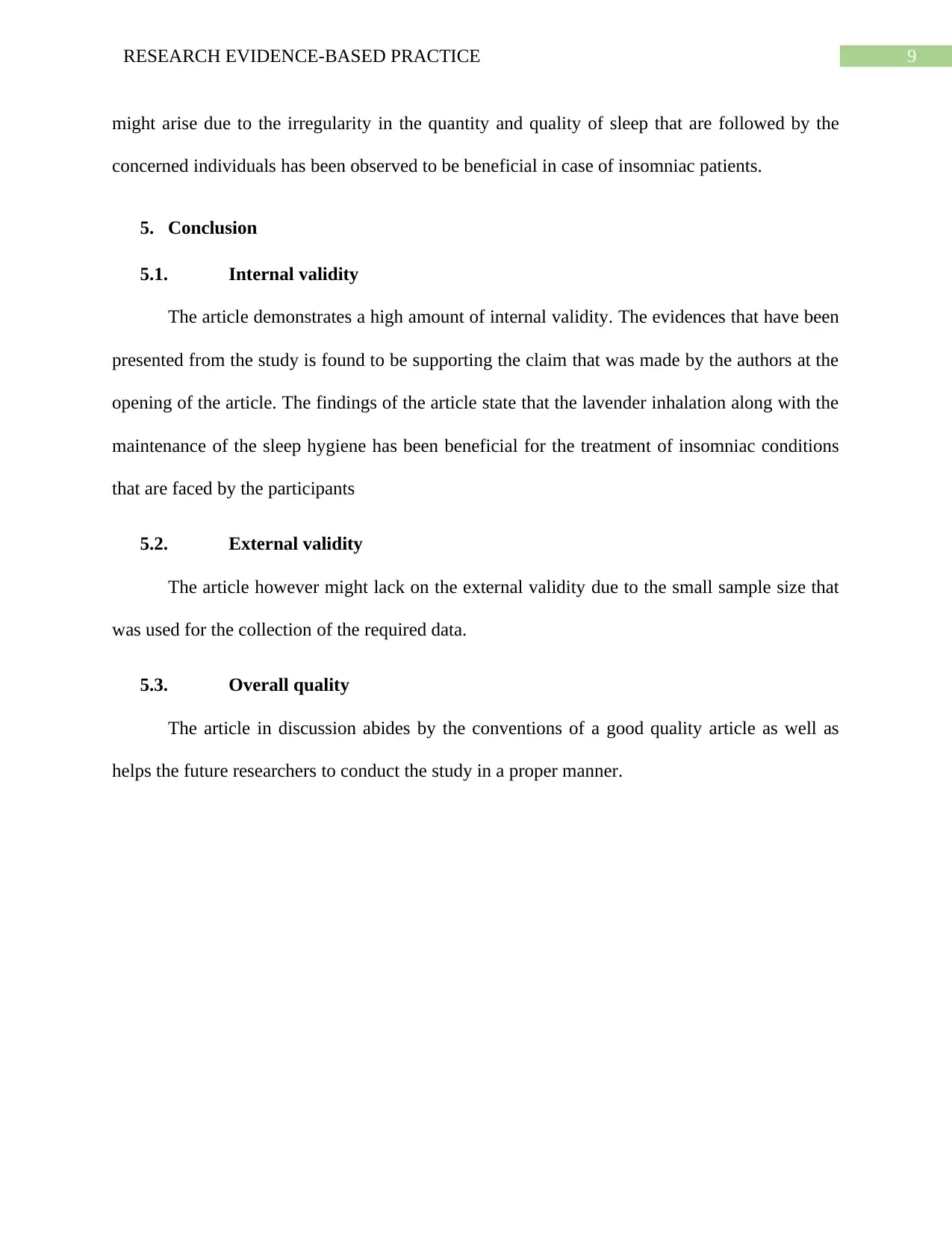
9RESEARCH EVIDENCE-BASED PRACTICE
might arise due to the irregularity in the quantity and quality of sleep that are followed by the
concerned individuals has been observed to be beneficial in case of insomniac patients.
5. Conclusion
5.1. Internal validity
The article demonstrates a high amount of internal validity. The evidences that have been
presented from the study is found to be supporting the claim that was made by the authors at the
opening of the article. The findings of the article state that the lavender inhalation along with the
maintenance of the sleep hygiene has been beneficial for the treatment of insomniac conditions
that are faced by the participants
5.2. External validity
The article however might lack on the external validity due to the small sample size that
was used for the collection of the required data.
5.3. Overall quality
The article in discussion abides by the conventions of a good quality article as well as
helps the future researchers to conduct the study in a proper manner.
might arise due to the irregularity in the quantity and quality of sleep that are followed by the
concerned individuals has been observed to be beneficial in case of insomniac patients.
5. Conclusion
5.1. Internal validity
The article demonstrates a high amount of internal validity. The evidences that have been
presented from the study is found to be supporting the claim that was made by the authors at the
opening of the article. The findings of the article state that the lavender inhalation along with the
maintenance of the sleep hygiene has been beneficial for the treatment of insomniac conditions
that are faced by the participants
5.2. External validity
The article however might lack on the external validity due to the small sample size that
was used for the collection of the required data.
5.3. Overall quality
The article in discussion abides by the conventions of a good quality article as well as
helps the future researchers to conduct the study in a proper manner.
Secure Best Marks with AI Grader
Need help grading? Try our AI Grader for instant feedback on your assignments.
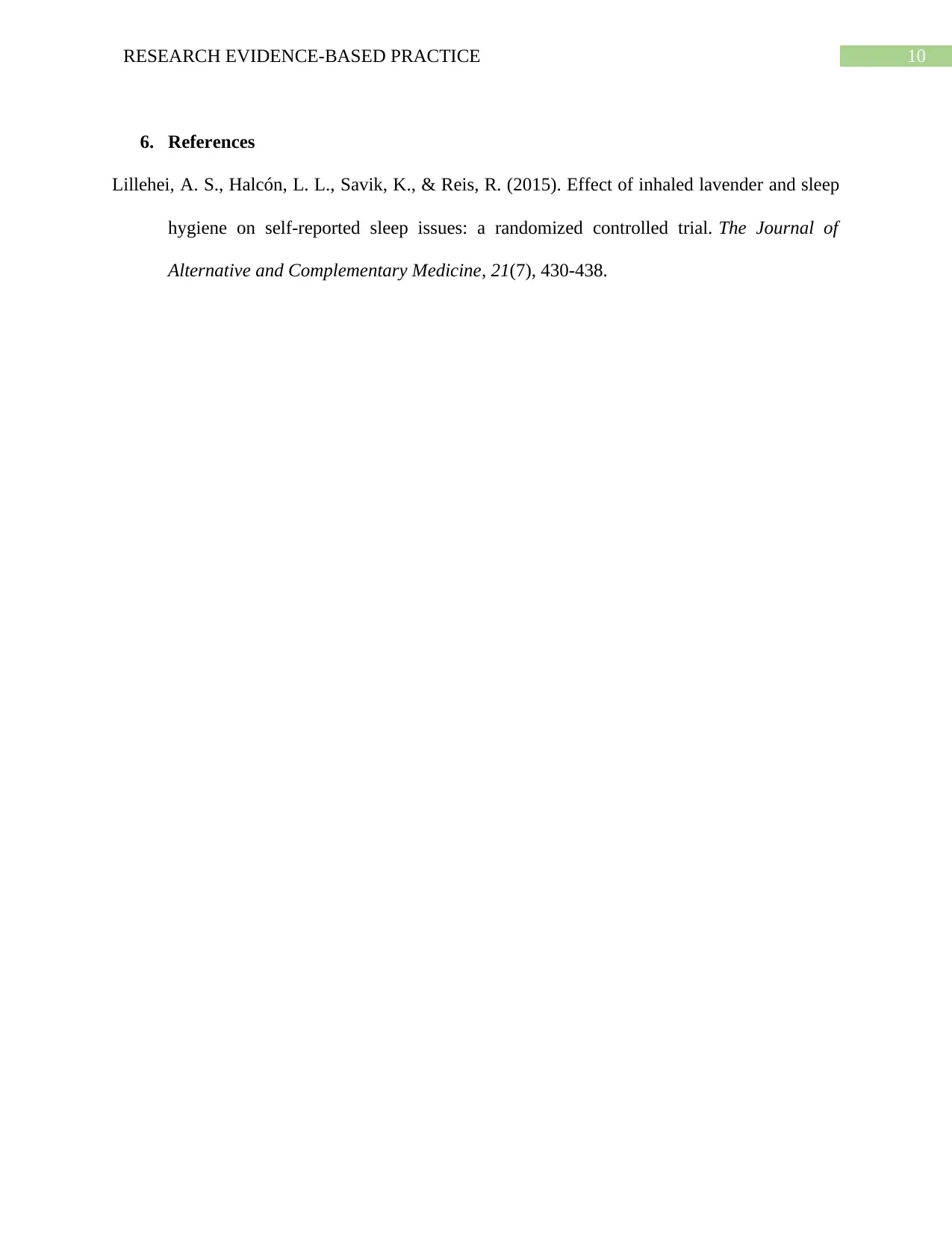
10RESEARCH EVIDENCE-BASED PRACTICE
6. References
Lillehei, A. S., Halcón, L. L., Savik, K., & Reis, R. (2015). Effect of inhaled lavender and sleep
hygiene on self-reported sleep issues: a randomized controlled trial. The Journal of
Alternative and Complementary Medicine, 21(7), 430-438.
6. References
Lillehei, A. S., Halcón, L. L., Savik, K., & Reis, R. (2015). Effect of inhaled lavender and sleep
hygiene on self-reported sleep issues: a randomized controlled trial. The Journal of
Alternative and Complementary Medicine, 21(7), 430-438.
1 out of 11
Related Documents
Your All-in-One AI-Powered Toolkit for Academic Success.
+13062052269
info@desklib.com
Available 24*7 on WhatsApp / Email
![[object Object]](/_next/static/media/star-bottom.7253800d.svg)
Unlock your academic potential
© 2024 | Zucol Services PVT LTD | All rights reserved.





